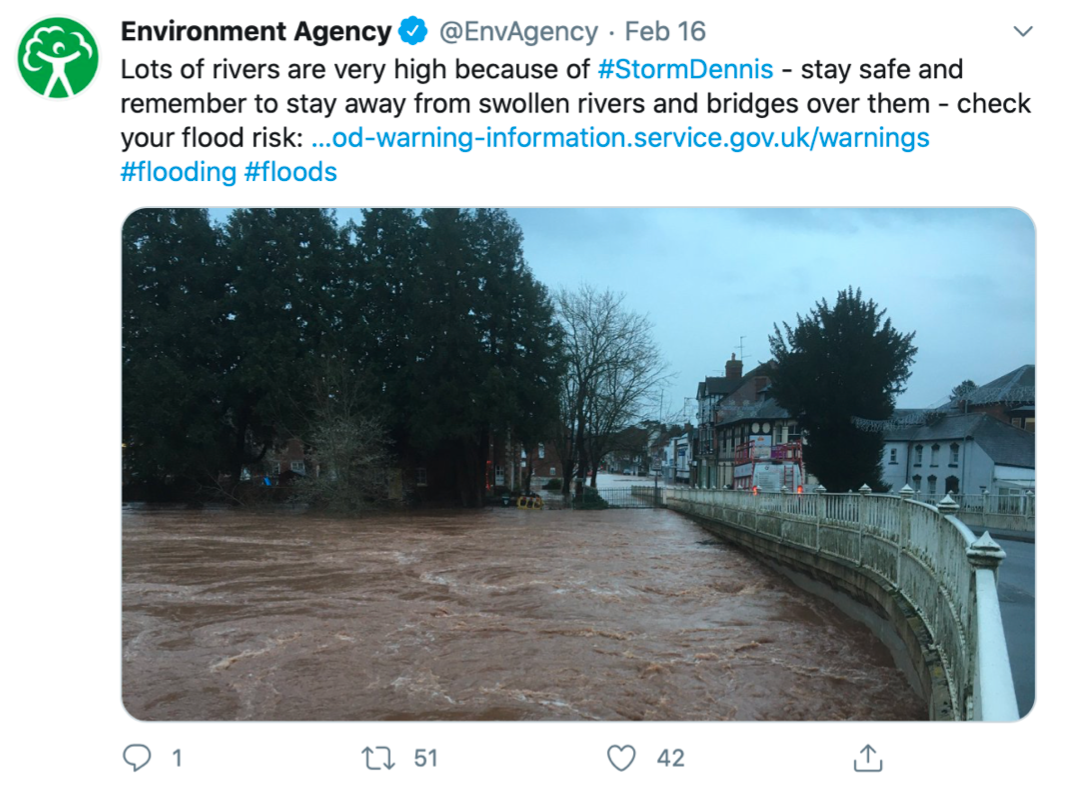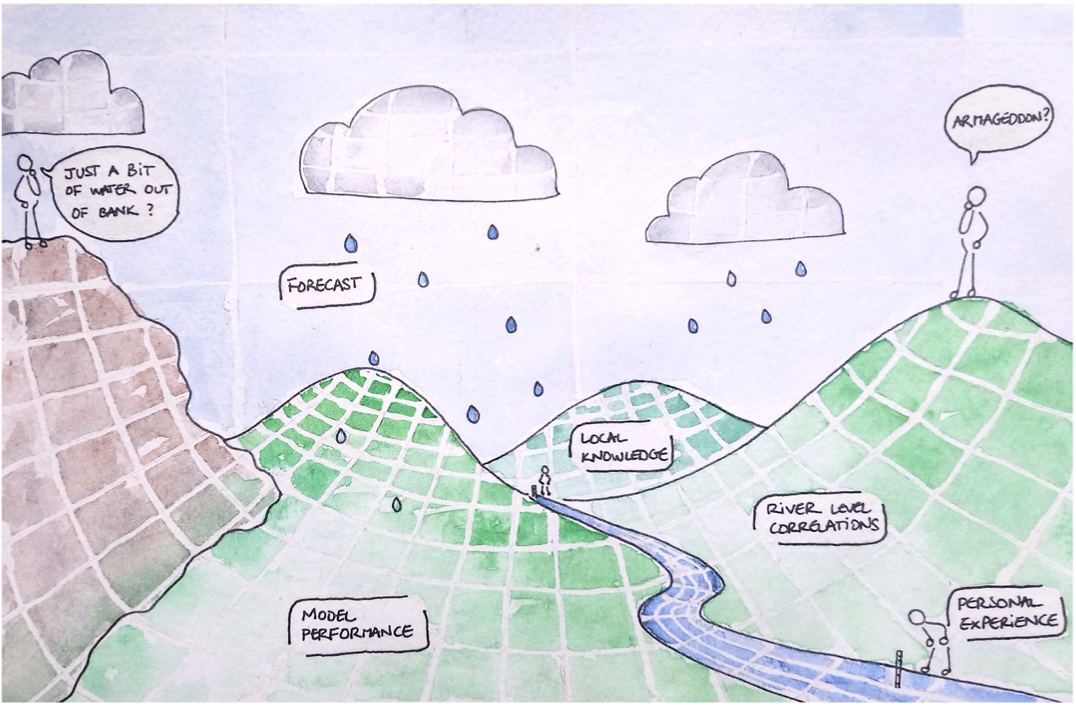“Are we talking just a bit of water out of bank? Or is it Armageddon?” Front line perspectives on transitioning to probabilistic fluvial flood forecasts in England
Contributed by Louise Arnal, Jess Neumann, Liz Stephens and Hannah Cloke
This blog post is based on a paper recently published in Geoscience Communication, written in collaboration with Liz Anspoks, Sue Manson, Tim Norton and Louise Wolfenden from the Environment Agency.
With the aim to better anticipate future floods, UK policy is seeing an ongoing shift from flood defence towards a forecast-based flood risk management approach, under the Flood and Water Management Act 2010. It is in this context that the Environment Agency, responsible for managing flood risks in England, recently published the National Flood and Coastal Erosion Risk Management Strategy for England, which states: “Alongside flood and coastal defences, we need a broader range of actions for achieving climate resilient places […] It involves better preparing and responding to flood and coastal incidents through timely and effective forecasting, warning and evacuation”.
This ongoing shift has shaped developments in the uptake of flood forecasting science in practice, often implemented in the wake of significant flood events. Just in time for the winter 2013/14 UK floods, the joint Environment Agency (EA) / Met Office Flood Forecasting Centre implemented ensemble surge forecasts operationally. Needless to say that these quickly demonstrated the value of ensemble forecasting for an earlier and better flood anticipation (see Stephens and Cloke, 2014 and the corresponding blog post). Around the same time, the EA moved from deterministic fluvial flood forecasting to using two fluvial flood scenarios, a Best Estimate1 and a Reasonable Worst Case2. Together, the two scenarios give an indication of the scale of the incident for planning and response preparations, with up to five days lead time (see the Flood Guidance Statement User Guide).
But the more recent winter 2019/20 UK floods (see the blog post by Helen Griffith, A Month of Storms) have hinted at the need for probabilistic fluvial flood forecasts, to better capture the uncertainty in upcoming fluvial floods and communicate risk more effectively:
“The recent floods exposed a limitation in our forecasting approach by only running flood models with a Best Estimate and Reasonable Worst Case meteorological inputs […] Being able to run meteorological ensembles through our flood forecasting models to determine the probability of different magnitudes of flood impacts within and across catchments would in my view have given us a better understanding of river response and allowed for clearer communication of risk from forecasters to responders […] There was a lot we did well but a lot we can do better.” (Neil Ryan, lead modelling and forecasting duty officer at the EA Leeds Forecasting Centre, March 2020)
Tweet from the Environment Agency about the UK floods caused by Storm Dennis in February 2020. Just a week after Storm Ciara hit the country (see Helen Griffith’s blog post, A Month of Storms).
The two scenarios are an intermediate step between deterministic and probabilistic fluvial flood forecasting and the EA is transitioning toward the operationalisation of probabilistic fluvial flood forecasting. While probabilistic forecasting can in theory allow an earlier and better flood anticipation, it is still unclear how this transition will affect EA decision-makers’ roles. This could be a barrier to the forecast implementation in practice.
During the summer of 2018, I carried out interviews with EA Duty Officers (decision-makers at the heart of the local flood decision-making process) across the country, to capture their perceptions with regards to this momentous transition. The interviews revealed the complex landscape in which EA Duty Officers work. While forecasting supports incident response by providing a critical piece of information, Duty Officers have to make trade-offs, taking different sources of information into consideration in their decision-making process, such as river level correlations, model performance, local knowledge, personal experience, internal procedures and politics.
Complex flood forecast interpretation landscape in which EA Duty Officers operate. This image was created using water paint by Louise Arnal and published in the paper in question.
The EA Duty Officers already communicate their confidence in the forecast to one another and the public using the two scenarios. However, the interviews also hinted at a decision-making process which is still binary and linear to an extent, illustrated by the title of the paper and an interview quote: “Are we talking just a bit of water out of bank? Or is it Armageddon?” This appears at odds with probabilistic forecasting and will likely have to change.
Through these interviews, we captured a diversity of opportunities and challenges perceived by the interviewed EA Duty Officers with regard to the transition, illustrated by the few selected quotes here:
“Whether it creates as many problems as it solves”
“In a good way it will reveal the uncertainty hidden by apparent simplicity”
“Having probabilistic forecasting just moves the burden of making a decision further down the tree”
In this paper, co-authored with the EA, we make 13 recommendations based on the interviews results to support a successful transition toward probabilistic fluvial flood forecasting. These include:
- Co-designing the probabilistic forecasting system and decision-making guidelines with both forecasters and decision-makers (e.g. EA Duty Officers) from across the country.
- Communicating (e.g. internally, and externally with emergency responders and the public) that probabilistic forecasting will become operational practice, clarifying the benefits of such a transition.
- Adapting the EA flood management priorities (e.g. moving towards warning lead times that reflect the probabilistic forecast predictability).
- Documenting this transition to help future EA transitions, as well as other institutes yet to face a similar challenge.
HEPEX has been making steady progress in probabilistic hydrological forecasting for over a decade. But putting research into operations is still far from easy given the challenges present at the intersections between forecasting and decision-making and those arising from the unique decision-making landscape. Such interviews are invaluable as they help us understand the world (of forecast-based flood risk management) as seen through the interviewees’ eyes, shedding light on potential bottlenecks and opportunities of operationalising probabilistic fluvial flood forecasting. But this is only one of a myriad of steps that can be implemented to ensure the transition is a success story.
In your opinion, which of these recommendations is most critical to ensure a successful transition in practice? Feel free to vote on this Twitter poll, or to comment under this post. We’d love to hear your thoughts!
The @EnvAgency is moving from 2 flood scenarios to probabilistic river flood forecasts. Based on interviews w. EA decision-makers (DM), we make recommendations to support a successful transition in practice. Which of these do you think is most critical?
— Dr Louise Arnal (@ArnalLouise) September 16, 2020
1The Best Estimate indicates what should happen (i.e. the middle range of forecast rainfall, river conditions and potential impacts) and should be used for planning where and when to issue flood warnings.
2The Reasonable Worst Case indicates what could happen (i.e. the upper range of forecast rainfall, river conditions and potential impacts) and should be used for preparation and informing others.


September 16, 2020 at 13:58
I am encouraged to see the UK Environment Agency beginning to move in the direction of probabilistic hydrologic forecasting; this is clearly the direction that operational hydrologic forecasting should be going (rapidly). While legacy single-valued deterministic hydrologic forecasting is still the norm in the United States, the NOAA National Weather Service has in place 4 operational and experimental ensemble hydrologic forecast systems. One of the systems, the MMEFS, a short lead-time (out 7-days) probabilistic hydrologic forecast system, was implemented operationally in January 2013 following several years of real-time operational testing. AHPS long lead-time (out to 90-days) hydrologic forecasts have been operational nationally for over a decade.
More recently, each of the 13 NOAA/NWS River forecast Centers, have begun to implement the nationally supported HEFS (hydrologic ensemble forecast system). Additionally, medium-range ensemble hydrologic forecasts are being tested at the National Water Center using the National Water Model. Verification studies have been encouraging.
NOAA/NWS AHPS
https://water.weather.gov/ahps/long_range.php
HEFS
https://water.weather.gov/ahps2/probability_information.php?wfo=pbz&gage=shrp1&graph_id=2
MMEFS
https://www.weather.gov/erh/mmefs
NWC
https://water.noaa.gov/map
September 16, 2020 at 15:05
Thank you for your comment and links Thomas! My personal hope is that sharing experiences in making this important operational transition to probabilistic flood forecasts will motivate other institutes yet to take this step.